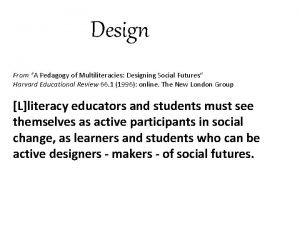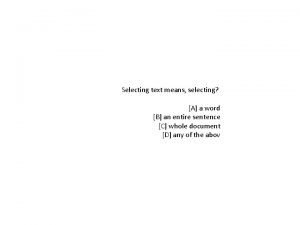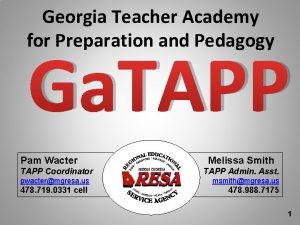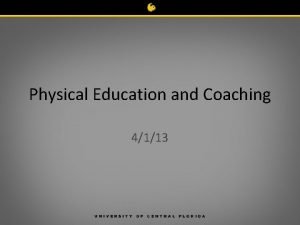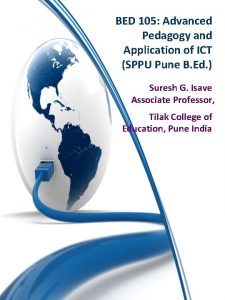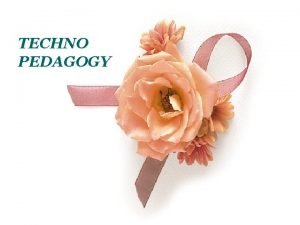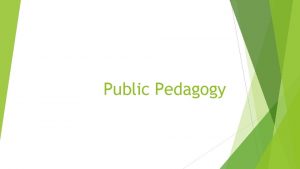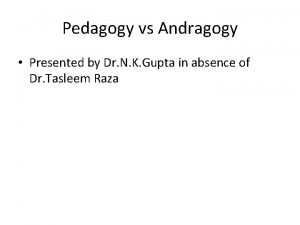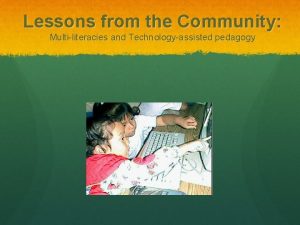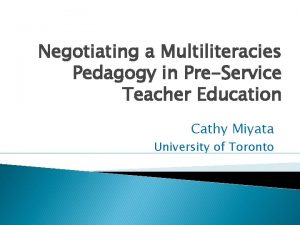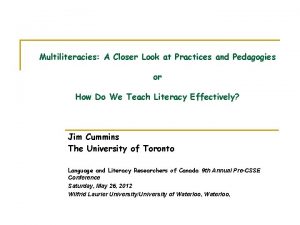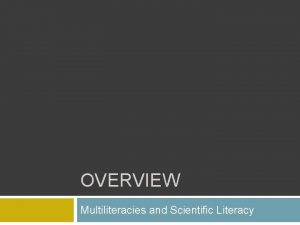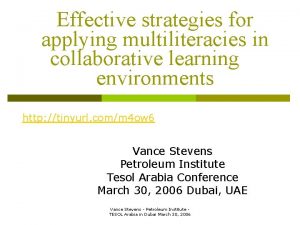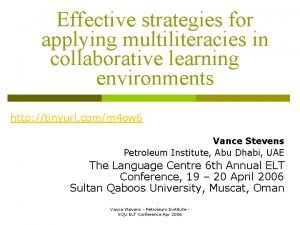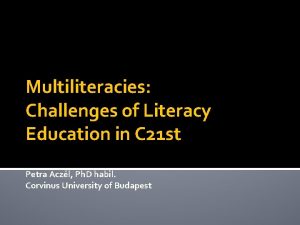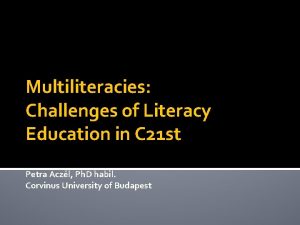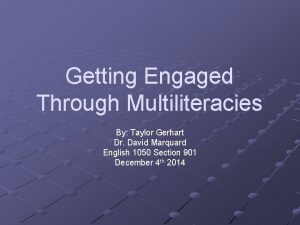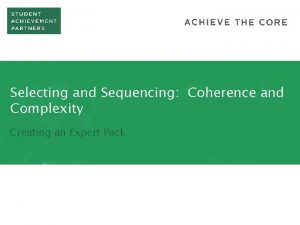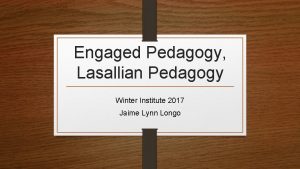Implementing a Pedagogy of Multiliteracies Selecting and Sequencing


















- Slides: 18

Implementing a Pedagogy of Multiliteracies: Selecting and Sequencing Content in Introductory Language Courses Heather Willis Allen, University of Miami Kate Paesani, Wayne State University

A Challenge to FL Programs “Replacing the two-tiered language-literature structure with a broader and more coherent curriculum in which language, literature, and culture are taught as a continuous whole … will reinvigorate language departments as valuable academic units central to the humanities and to the missions of higher education” (MLA, 2007, p. 3)

Literacy as a Curricular Goal “Literacy is the use of socially-, historically-, and culturallysituated practices of creating and interpreting meaning through texts. It entails at least a tacit awareness of the relationships between textual conventions and their contexts of use, and ideally, the ability to reflect critically on these relationships. Because it is purpose-sensitive, literacy is dynamic - not static - and variable across and within discourse communities and cultures. It draws on a wide range of cognitive abilities, on knowledge of written and spoken language, on knowledge of genres, and on cultural knowledge” (Kern, 2000, p. 16).

Literacy & Available Designs l Available Designs include all resources - linguistic, social, cultural - a reader brings to a text to create meaning l Available Designs involve a reader’s existing linguistic structures and knowledge resources that are drawn on, consciously or unconsciously, in interpreting texts l A reader uses Available Designs to engage in Designing, the process of accessing, applying, and recycling known concepts in fresh ways

Literacy & Available Designs LINGUISTIC SCHEMATIC writing system vocabulary syntax cohesion / coherence formal schemata genre / style content schemata stories

Literacy & Genre l Genre: “an oral or written rhetorical practice that structures culturally embedded communicative situations in a highly predictable pattern, thereby creating horizons of expectations for its community of users” (Swaffar & Arens, 2005, p. 99)

Private <----------------> Public Type of Communication Informal examples Formal Examples Written and personal Letter Business letter Blog Diary Montage, scrapbook Business diary Spoken Conversation Ad hoc speech, monologue Debate Oratory, homily Printed or published Letter to the editor Expository prose: general periodical, self-published nonfiction book Fiction and other literary genres in limited used contexts Review Expository prose: specialized periodical, book from established press, handbook, encyclopedia Popular fiction, driven by formulas


Available Designs & Genre = content = what to teach Principles of Literacy = learning processes = how to teach Curricular Components = instructional activities = application of what and how New London Group (1996), Kern (2000)

Literacy- & Genre-Oriented Curricula: Research Gaps l Greater focus on advanced-level courses, contribution of literacy/genre-based approaches to the development of “advancedness” (Byrnes, Maxim & Norris, 2010) l Little empirical research into models and outcomes of literacy/genre-based approaches; most existing research is specific to advanced levels (Maxim, 2002, 2006; Ortega & Byrnes, 2008) l Literature is under-represented in lower levels within each proposed genre continuum

Challenges in the Introductory FL Curriculum l Classroom pedagogy l l l Teacher preparation & professional development l l Continued dominance of CLT techniques & goals Propensity to artificially separate language/literary-cultural content Commercial pedagogical materials still dominated by CLT The “one shot” model: Limited opportunities for graduate students’ professional development as teachers Lack of depth in models for teaching reading & writing Content & the Curriculum “by default”: The textbook Allen & Negueruela-Azarola (2010), Allen & Paesani (2010), Askildson (2008)

Challenges in the Introductory FL Curriculum: The textbook “In our world, it is the norm for professors using our textbooks to tell us that they ‘never cover the culture; there’s just no time for it. ’ And in our world, it is our consistent experience that the single most important determining factor in adoption decisions at the college level is the grammar sequence around which a given textbook is structured” (Dorwick & Glass, 2003, p. 593)

An example: Textual coverage in two Introductory French textbooks Deux Mondes, 5 th ed. Literary texts per. 42 chapter Literary genres* Chez Nous, 4 th ed. 1. 00 poem (2), fairy tale (1), poems (4), novel (4), play short story (1), play (1) (2), short story (1), folk tale (1), Non-literary texts 2. 29 per chapter 2. 92 Most frequently appearing nonliterary genres table/chart/graph (9), map (3), advertisement (2) advertisement (19), cartoon (3) * besides poems, these appear as short excerpts

Selecting Content l Connecting GENRE and AVAILABLE DESIGNS l l What are the linguistic and schematic resources that characterize the private/public genres appropriate for use in introductory courses? Connecting LINGUISTIC and SCHEMATIC resources l l How do the schematic available designs characteristic of a genre manifest themselves linguistically? How do the linguistic available designs characteristic of a genre manifest themselves schematically?

Selecting Content: Linking linguistic & schematic resources l Content Schemata: background knowledge as an essential component in textual understanding for beginning learners l l Formal Schemata: predictable rhetorical organization make texts accessible to beginning learners l l LINK TO: vocabulary (frequency, complexity, formulae) LINK TO: writing systems (headers, graphic conventions) Genre / Style: expectations about content and form as an entry point to various genres l LINK TO: syntax (pronoun use, sentence length, formulae)

Sequencing content: Mapping textual genres onto the introductory FL curriculum l Consider focusing on one recurring textual genre across an introductory course (Maxim, 2006; Mills, 2009) l Supplement the recurrent genre with varied additional texts representing primary & secondary discourses (Allen & Paesani, 2010) l Design instruction & assessment that requires learners to construct textual meaning that demonstrates knowledge of linguistic & schematic resources related to specific textual genres


Conclusion l Unexplored questions: l l l How many instantiations of each genre across courses? What is the role of extensive reading / longer texts? Future directions: l l Template for mapping content across introductory courses Empirical research investigating feasibility of this approach & students’ linguistic outcomes at introductory levels
 A pedagogy of multiliteracies: designing social futures
A pedagogy of multiliteracies: designing social futures Selecting text means selecting
Selecting text means selecting Georgia tapp program
Georgia tapp program What is sport pedagogy
What is sport pedagogy Advanced pedagogy and application of ict
Advanced pedagogy and application of ict Epistemology and pedagogy
Epistemology and pedagogy Chapter 7 strategic management
Chapter 7 strategic management Strategic management chapter 7
Strategic management chapter 7 Implementing strategies: management and operations issues
Implementing strategies: management and operations issues Tripod pricing strategy
Tripod pricing strategy Toyota brand hierarchy
Toyota brand hierarchy Designing and implementing brand architecture
Designing and implementing brand architecture Crm vision statement example
Crm vision statement example Implementing strategies management and operations issues
Implementing strategies management and operations issues Designing and implementing brand architecture strategies
Designing and implementing brand architecture strategies Implementing strategies management and operations issues
Implementing strategies management and operations issues Techno-pedagogy
Techno-pedagogy Public pedagogy definition
Public pedagogy definition Pedagogy vs androgogy
Pedagogy vs androgogy
